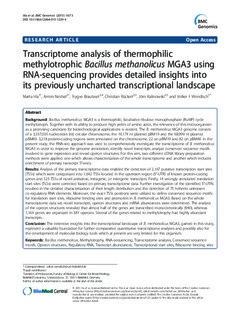| dc.contributor.author | Irla, Marta | |
| dc.contributor.author | Neshat, Armin | |
| dc.contributor.author | Brautaset, Trygve | |
| dc.contributor.author | Rückert, Christian | |
| dc.contributor.author | Kalinowski, Jörn | |
| dc.contributor.author | Wendisch, Volker F. | |
| dc.date.accessioned | 2019-11-13T10:27:38Z | |
| dc.date.available | 2019-11-13T10:27:38Z | |
| dc.date.created | 2015-06-18T09:55:41Z | |
| dc.date.issued | 2015 | |
| dc.identifier.citation | BMC Genomics. 2015, 16:73 (1), . | nb_NO |
| dc.identifier.issn | 1471-2164 | |
| dc.identifier.uri | http://hdl.handle.net/11250/2628142 | |
| dc.description.abstract | Background Bacillus methanolicus MGA3 is a thermophilic, facultative ribulose monophosphate (RuMP) cycle methylotroph. Together with its ability to produce high yields of amino acids, the relevance of this microorganism as a promising candidate for biotechnological applications is evident. The B. methanolicus MGA3 genome consists of a 3,337,035 nucleotides (nt) circular chromosome, the 19,174 nt plasmid pBM19 and the 68,999 nt plasmid pBM69. 3,218 protein-coding regions were annotated on the chromosome, 22 on pBM19 and 82 on pBM69. In the present study, the RNA-seq approach was used to comprehensively investigate the transcriptome of B. methanolicus MGA3 in order to improve the genome annotation, identify novel transcripts, analyze conserved sequence motifs involved in gene expression and reveal operon structures. For this aim, two different cDNA library preparation methods were applied: one which allows characterization of the whole transcriptome and another which includes enrichment of primary transcript 5′-ends. Results Analysis of the primary transcriptome data enabled the detection of 2,167 putative transcription start sites (TSSs) which were categorized into 1,642 TSSs located in the upstream region (5′-UTR) of known protein-coding genes and 525 TSSs of novel antisense, intragenic, or intergenic transcripts. Firstly, 14 wrongly annotated translation start sites (TLSs) were corrected based on primary transcriptome data. Further investigation of the identified 5′-UTRs resulted in the detailed characterization of their length distribution and the detection of 75 hitherto unknown cis-regulatory RNA elements. Moreover, the exact TSSs positions were utilized to define conserved sequence motifs for translation start sites, ribosome binding sites and promoters in B. methanolicus MGA3. Based on the whole transcriptome data set, novel transcripts, operon structures and mRNA abundances were determined. The analysis of the operon structures revealed that almost half of the genes are transcribed monocistronically (940), whereas 1,164 genes are organized in 381 operons. Several of the genes related to methylotrophy had highly abundant transcripts. Conclusion The extensive insights into the transcriptional landscape of B. methanolicus MGA3, gained in this study, represent a valuable foundation for further comparative quantitative transcriptome analyses and possibly also for the development of molecular biology tools which at present are very limited for this organism. Keywords: Bacillus methanolicus ; Methylotrophy; RNA-sequencing; Transcriptome analysis; Conserved sequence motifs; Operon structures; Regulatory RNA; Transcript abundances; Transcriptional start sites; Ribosome binding sites | nb_NO |
| dc.description.abstract | Transcriptome analysis of thermophilic methylotrophic Bacillus methanolicus MGA3 using RNA-sequencing provides detailed insights into its previously uncharted transcriptional landscape | nb_NO |
| dc.language.iso | eng | nb_NO |
| dc.publisher | BMC (part of Springer Nature) | nb_NO |
| dc.rights | Navngivelse 4.0 Internasjonal | * |
| dc.rights.uri | http://creativecommons.org/licenses/by/4.0/deed.no | * |
| dc.title | Transcriptome analysis of thermophilic methylotrophic Bacillus methanolicus MGA3 using RNA-sequencing provides detailed insights into its previously uncharted transcriptional landscape | nb_NO |
| dc.type | Journal article | nb_NO |
| dc.type | Peer reviewed | nb_NO |
| dc.description.version | publishedVersion | nb_NO |
| dc.source.pagenumber | 22 | nb_NO |
| dc.source.volume | 16:73 | nb_NO |
| dc.source.journal | BMC Genomics | nb_NO |
| dc.source.issue | 1 | nb_NO |
| dc.identifier.doi | 10.1186/s12864-015-1239-4 | |
| dc.identifier.cristin | 1249021 | |
| dc.description.localcode | © 2015 Irla et al.; licensee BioMed Central. This is an Open Access article distributed under the terms of the Creative Commons Attribution License (http://creativecommons.org/licenses/by/4.0), which permits unrestricted use, distribution, and reproduction in any medium, provided the original work is properly credited. The Creative Commons Public Domain Dedication waiver (http:// | nb_NO |
| cristin.unitcode | 194,66,15,0 | |
| cristin.unitname | Institutt for bioteknologi og matvitenskap | |
| cristin.ispublished | true | |
| cristin.fulltext | original | |
| cristin.qualitycode | 1 | |

